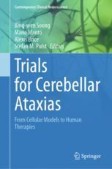Search
Search Results
-

-
Prevalence of repeat expansions causing autosomal dominant spinocerebellar ataxias in Hokkaido, the northernmost island of Japan
In Japan, approximately 30% of spinocerebellar degeneration (SCD) is hereditary, and more than 90% of hereditary SCD is autosomal dominant SCD...

-
Epidemiology of Spinocerebellar Ataxias in Europe
Spinocerebellar ataxias (SCAs) are a heterogenous group of rare neurodegenerative conditions sharing an autosomal dominant pattern of inheritance....

-
Cerebellar Degeneration Associated with HIV Infection
Objectives . To describe the features of the clinical picture and estimate the incidence of HIV-associated cerebellar degeneration in patients with...
-
Therapy Development for Spinocerebellar Ataxia: Rating Scales and Biomarkers
Spinocerebellar ataxias (SCAs) are a group of dominantly inherited disorders with progressive cerebellar dysfunction. Although there are no Food and...
-
Autosomal Dominant Spinocerebellar Ataxias and Episodic Ataxias
Hereditary autosomal dominant spinocerebellar ataxias (ADCAs) are a clinically and genetically heterogeneous group of disorders consisting of 31...
-
Spinocerebellar Ataxia Type 7: From Mechanistic Pathways to Therapeutic Opportunities
Spinocerebellar ataxiaSpinocerebellar ataxia (SCA) type 7 (SCA7) is a cerebellar and retinal neurodegenerative diseaseNeurodegenerative diseases...
-
Potential Clinical Benefit of Very Long Chain Fatty Acid Supplementation in Spinocerebellar Ataxia Type 34
Spinocerebellar ataxia type 34 (SCA34) is a dominantly inherited disease that causes late-onset ataxia, in association with skin lesions in the form...
-
Two New Families and a Literature Review of ELOVL4-Associated Spinocerebellar Ataxia Type 34
Autosomal dominant variants in ELOVL4 cause spinocerebellar ataxia type 34 (SCA34; ATX- ELOVL4 ), classically associated with a skin condition known as...

-
Intermuscular Coherence in Spinocerebellar Ataxias 3 and 6: a Preliminary Study
Spinocerebellar ataxias (SCAs) are familial neurodegenerative diseases involving the cerebellum and spinocerebellar tracts. While there is variable...

-
A novel ELOVL4 variant, L168S, causes early childhood-onset Spinocerebellar ataxia-34 and retinal dysfunction: a case report
Spinocerebellar ataxia 34 (SCA34) is an autosomal dominant inherited disease characterized by age-related cerebellar degeneration and ataxia caused...

-
Seeking Therapies for Spinocerebellar Ataxia: From Gene Silencing to Systems-Based Approaches
Recent progress has led to nucleotide-based gene silencing strategies as a potential therapy for spinocerebellar ataxia type 3 (SCA3) and other...
-
Reactive Bergmann glia play a central role in spinocerebellar ataxia inflammation via the JNK pathway
The spinocerebellar ataxias (SCAs) are devastating neurological diseases characterized by progressive cerebellar incoordination. While neurons bear...

-
The Cerebellar Cognitive Affective/Schmahmann Syndrome Scale in Spinocerebellar Ataxias
The Cerebellar Cognitive Affective/Schmahmann Syndrome (CCAS) manifests as impaired executive control, linguistic processing, visual spatial...

-
Spinocerebellar ataxia type 17-digenic TBP/STUB1 disease: neuropathologic features of an autopsied patient
Spinocerebellar ataxia (SCA) type 17-digenic TBP/STUB1 disease (SCA17-DI) has been recently segregated from SCA17, caused by digenic inheritance of...

-
A Proposal for Classification of Retinal Degeneration in Spinocerebellar Ataxia Type 7
The aim of this study is to propose a classification system for the spinocerebellar ataxia type 7 retinal degeneration (SCA7-RD). Twenty patients...

-
Novel CWF19L1 mutations in patients with spinocerebellar ataxia, autosomal recessive 17
Spinocerebellar ataxia, autosomal recessive-17 (SCAR17) is a rare hereditary ataxia characterized by ataxic gait, cerebellar signs and occasionally...

-
Spinocerebellar ataxia type 31 (SCA31)
Spinocerebellar ataxia type 31 (SCA31) is one of the most common forms of autosomal-dominant cerebellar ataxia in Japan. SCA31 has a strong founder...

-
The Spinocerebellar Ataxia 34-Causing W246G ELOVL4 Mutation Does Not Alter Cerebellar Neuron Populations in a Rat Model
Spinocerebellar ataxia 34 (SCA34) is an autosomal dominant disease that arises from point mutations in the fatty acid elongase, Elongation of Very...

-
Structural Brain Correlates of Sleep Microstructure in Spinocerebellar Ataxia Type 2 and its Role on Clinical Phenotype
The influence of brain atrophy on sleep microstructure in Spinocerebellar Ataxias (SCAs) has not been extensively explored limiting the use of these...

